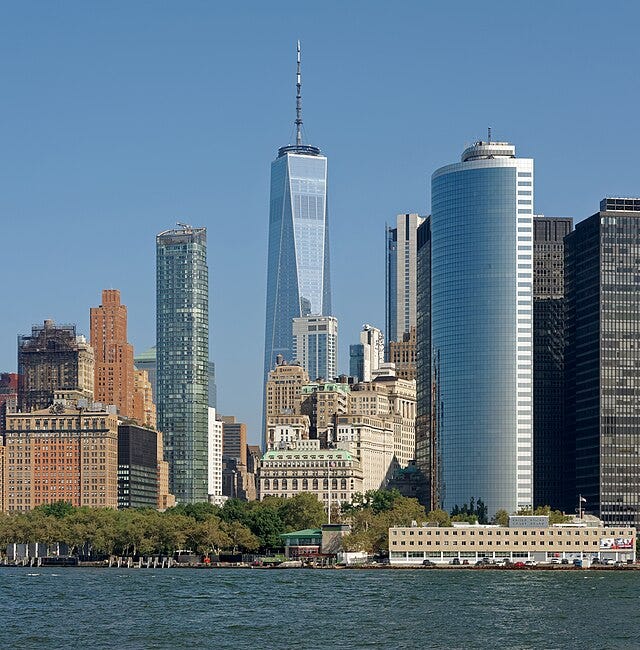
By the time you’re reading this, over 100k voters will have voted in the primaries for New York City’s mayorship, a city that is both diverse and liberal while also getting more conservative in the Trump era thanks to said minorities lurching hard to the right. It also happens to be the home for nearly nine million Americans, with its anchoring metro being home to tens of millions more and serving as the cultural and media capital of not just the United States, but also of the larger Western world, despite the protests of Los Angeles and London. When anyone in the world is asked to name a city in the United States, odds are that they will speak the name of the Big Apple. Despite the Apple’s reddening hue, the GOP primary isn’t one at all. 2021 nominee and Guardian Angels founder Curtis Sliwa was the only candidate to make the GOP ballot this year, ensuring his appearance on the 2025 general election ballot barring death or some other shocking event. Independents Jim Walden, a high-profile lawyer, and incumbent Mayor Eric Adams will also appear on the general election ballot. However, this is not a place to talk about the general election. This is a place to talk about the election that is still largely tantamount to a general election in NYC: the Democratic primary. Eleven candidates have made the Democratic ballot this year, all with differing stories and viabilities for a race that, as often happens in NYC, has taken on a life far beyond the issues being fought over, with the primary offering one of the first clues into a very diverse set of Democratic voters two weeks after New Jersey held its primaries. With a national party base increasingly incensed with its own party and the potential for a 2007 Appalachian State-style upset in the race, here is the hater’s guide to the Democratic primary for Mayor of New York City.
Who?
Let’s just get the absolute no-hopers out of the way. Selma Bartholomew is a Harlem-raised educator with campaign headquarters in the Bronx who is campaigning on establishing a quality of life index assessment, cleaning up the city’s streets, investing deeply into STEAM and extracurricular-based education, and giving free metro cards to 18-21 year old New Yorkers. Look for her strongest support to be among Black New Yorkers, although that’s not saying much given her 1% polling.
Paperboy Love Prince is the progressive meme candidate. A music artist, former 2020 primary challenger to Rep. Nydia Velazquez, and 2021 candidate for Mayor, their campaign ad is titled “Send in the Clowns.” It’s a more fitting description of the Trump administration’s invasion of Los Angeles than anything else. If one puts the glitter and clown makeup to the side, Prince is actually running on a very detailed left-wing agenda: highlights include housing and jobs guarantees, increasing the arts budget to 1% of GDP, a 32-hour work week, and a promise to eradicate poverty. With headquarters in Bushwick, Brooklyn, you could make an argument for a few areas to be Paperboy Prince’s strongest areas: maybe it’s the Commie Corridor, maybe it’s the progressive brownstones in Brooklyn, maybe it’s Black Brooklyn. What I do know is that they won’t be the next Mayor.

Neither will Whitney Tilson, a wealthy former hedge fund executive formerly backed by Bill Ackman whose job it is to attack one of the frontrunners in the race and eat up second-choice votes from the other’s backers. His platform is mostly about fighting crime: highlights include hiring 5,000 more cops, banning street homelessness, and being very, very YIMBY in his housing affordability approach; he says the City of Yes proposal didn’t go nearly far enough. Look for his strength to be concentrated in Manhattan, particularly on the Upper East Side and possibly in the Financial District, as one would expect from a former hedge fund executive.

Regional Players
Michael Blake, a former State Assemblymember, DNC Vice Chair, and candidate for Public Advocate (2019) and NY-15 (2020), has risen in many progressives’ eyes for his vicious attacks on the polling leader of the race in the June 4th debate. This has led to him earning a spot down the ballots of many left-wing voters. His first-choice support is expected to be incredibly concentrated in his native Bronx, although I could see him earning some support from Black voters in Brooklyn and Queens. The key word is could, and his polling is absolutely terrible, even worse than Tilson’s. Blake has since endorsed the major left-wing candidate, who we’ll get to later, as his second rank, in a sort of Hater’s Coalition against the other main frontrunner.
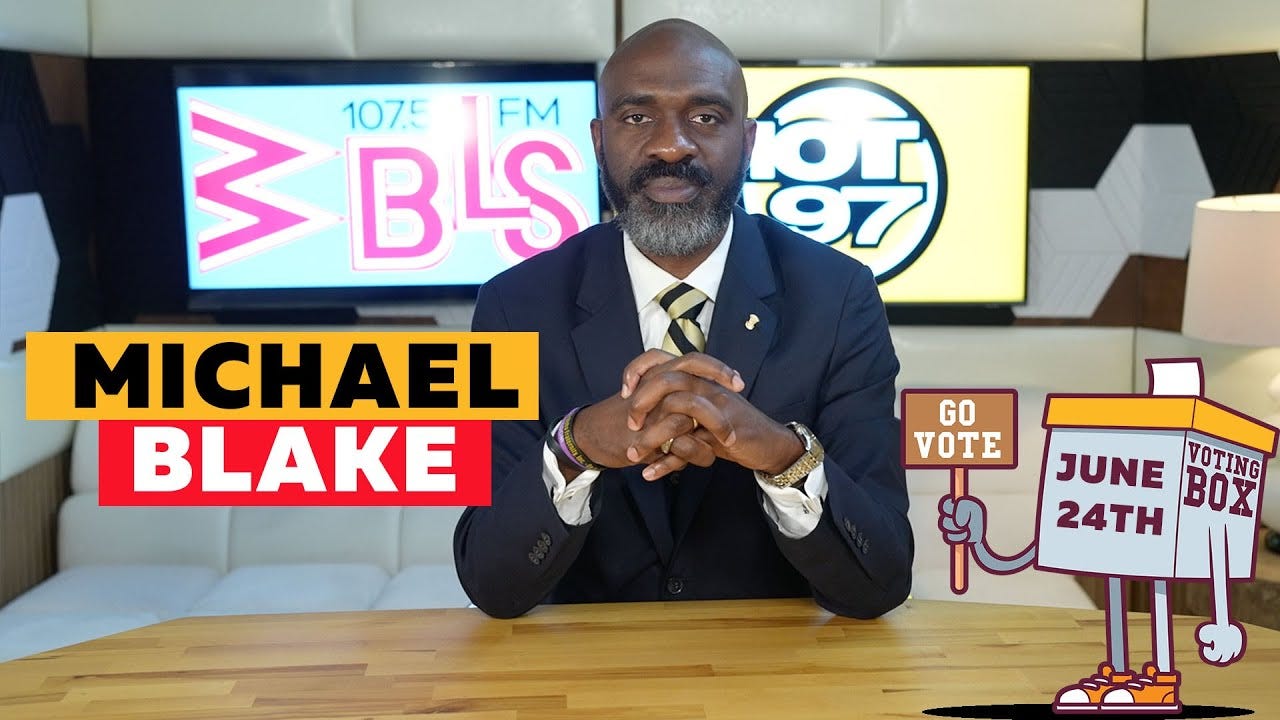
Blake’s status in the DREAM slate is in stark contrast to State Sen. Jessica Ramos, the jilted ex of the left whose endorsement of the polling frontrunner just after the first debate made more headlines for the sheer vitriol she received from the city’s progressives than the endorsement itself. Note that said frontrunner is not even endorsing her campaign in response. Ramos, a Colombian-American politician who represents Corona, East Elmhurst, and Jackson Heights in the State Senate, would have her strength concentrated there, as well as Latino communities across the city, with very little support elsewhere in NYC. She may slightly benefit from the Dianne Morales effect of putting up decent performances in heavily Dominican and Puerto Rican areas of the Bronx due to her last name.
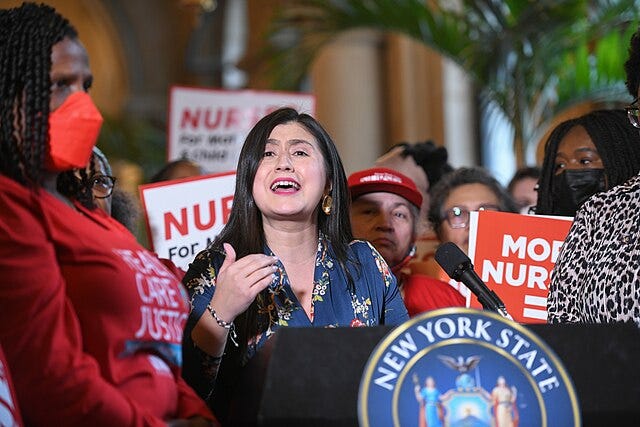
State Sen. Zellnor Myrie of Prospect Lefferts Gardens, itself a battleground neighborhood, is running as the YIMBY candidate in the race. Despite a decently impressive fundraising haul, Myrie has simply not managed to break ahead of the pack and is relegated to being ranked down the ballot of many left-wing and YIMBY voters. I would expect his first preferences to be concentrated in Brooklyn, especially in his State Senate district, which includes Crown Heights and Windsor Terrace, and I believe he could earn some support among Black Brooklynites as well. He might also perform well in Manhattan, but there doesn’t seem to be many constituencies in the outer boroughs sans Brooklyn where Myrie could have some level of support.
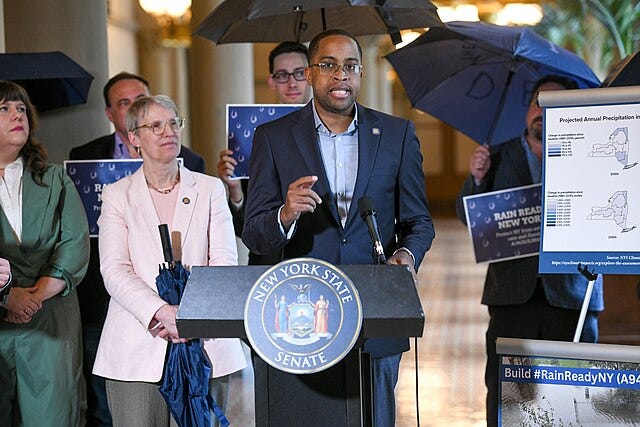
Serious Candidates, Yet Can’t Win
Former NYC Comptroller Scott Stringer was once making it to the final round of the earliest polls, which is a position he sorely wishes he could be in right now. He is the definition of a Manhattan establishment liberal, having got his start as a State Assemblymember from the Upper West Side in the 1990s before winning the Manhattan borough Presidency in 2005. Stringer served there until he won a 2013 election to become the City Comptroller, preceding another one of the serious candidates who can’t win. He is in a very weird spot; he is certainly above the other candidates listed, but is very much not a frontrunner and is not going to become Mayor. Blame his 2021 sexual harassment allegations for that. With a home base in Manhattan’s Upper West Side, I would also expect Stringer to perform his best in Manhattan and, interestingly, East Asian voters across the city. Neighborhoods with large East Asian populations are where Stringer has led the other candidates in fundraising, and he already put up decent numbers in some of these areas in 2021.
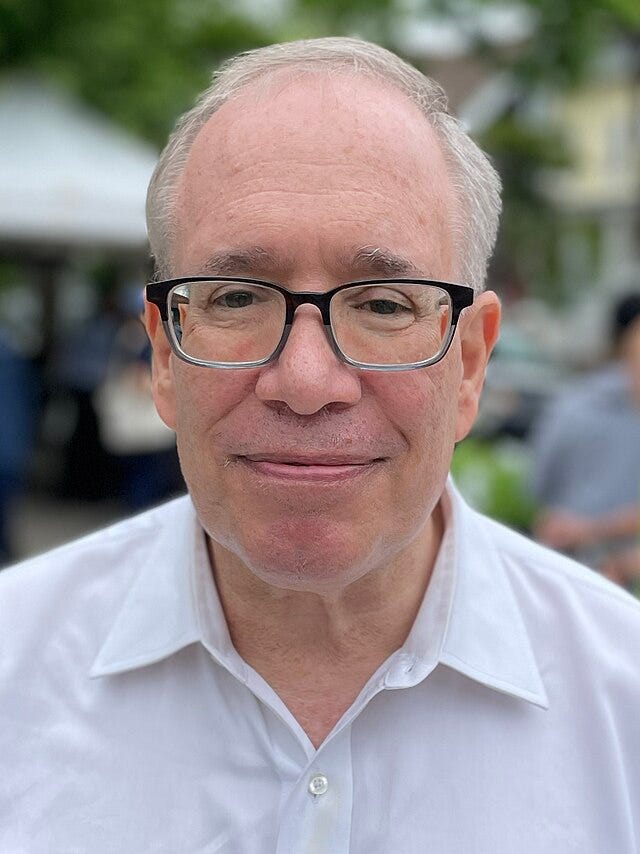
In another world, Adrienne Adams could win this race. The City Council President entered the race extremely late, offering herself as a choice for establishment-minded liberals who both didn’t care too much for the moderate frontrunner and weren’t comfortable with either of the two main left-wing candidates. There are reasons for why she could have won in a different universe. First off, her base is the very same main base that Eric Adams had in his 2021 win: black voters. While Eric’s was in Brooklyn and Adrienne’s is in Queens, a late TV push from Adams, which she has the matching funds to do, could shore her up with those voters and introduce her to new voters who aren’t enthused with either major frontrunner. Additionally, the left of New York, including AOC and the Working Families Party, has been decisive and strategic by including her in their broader DREAM slate, which will earn her some support from progressive voters, albeit most likely not first-choice votes. This would be crucial if she could somehow vault herself into a clear top three, as progressives nearly hauled liberal Sanitation Commissioner Kathryn Garcia above Eric Adams four years ago and could do more for Adrienne Adams this time around. The problem? She’s polling in the mid to high single digits and usually isn’t even making it to the last three. Her late entrance in March and, importantly, low name recognition has blocked her from being anything but a secondary contender and the two main frontrunners have sucked up too much of the energy in the race. Additionally, one of them is doing far too well among Black voters for Adams to have a shot of being a main contender.

For Brad Lander, take what I said about Adrienne Adams in the last couple of sentences and apply that to his base. He’s a classic Park Slope progressive, a longtime DSA member in his own right who has the left and Manhattan liberals to thank for his 4 point win over Corey Johnson in the 2021 Democratic Comptroller primary. The former City Councilmember, who succeeded a certain Bill de Blasio in 2010, started out as the main left-wing candidate in this race, and unlike most other contenders, he has a roadmap for beating a white candidate strongest with Black and moderate voters in a citywide election. Unlike Adrienne Adams, he was one of the first Democrats to enter the race (then against Eric Adams), but like Adrienne Adams, however, his main issue is that his would-be base of first choice voters has simply been wooed over by a frontrunner. Even worse for Lander is that, according to the latest polling, that frontrunner has built a very strong base with voters that would have otherwise gone for him, and they are very enthusiastic about getting their guy elected. The Working Families Party relegated him to their second choice, and AOC didn’t even do that for him, ranking Adams above Lander for that spot. He is absolutely fucked in a way I wouldn’t even describe Adams’s campaign simply because his base has been won over, whereas Adams is trying to win over her base from another candidate. Even Park Slope, his true home base, is likely going for the actual left-wing frontrunner over him. Brad Lander’s 2025 mayoral campaign will go down as one of the more underrated bag fumbles of 2020s Democratic politics. While he will be on a lot of people’s ballots, most of those will not rank him first, and he has decided to go for a formal alliance with his allied frontrunner, ranking him second and relegating himself to being a junior partner of the broader left coalition in the city.
UPDATE: While I was writing this, Lander managed to get himself detained by ICE after asking for a judicial warrant while escorting a defendant out of immigration court. He, a citywide elected official, is still in the custody of federal agents at the time of publication. Such an arrest is both a shocking development in the relationship between the regime and opposition officials and exactly what Lander needed to revitalize his campaign, if only to secure 3rd place from Adrienne Adams.
Now, it’s time for me to do something I am yet to do in this article and actually name the two candidates that have emerged from the pack.
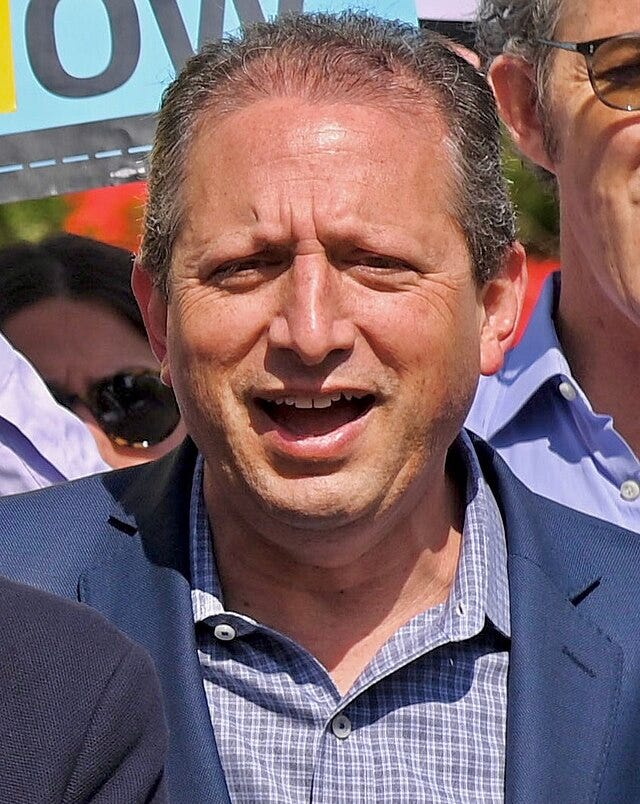
The Frontrunners
Cuomo’s Great Comeback
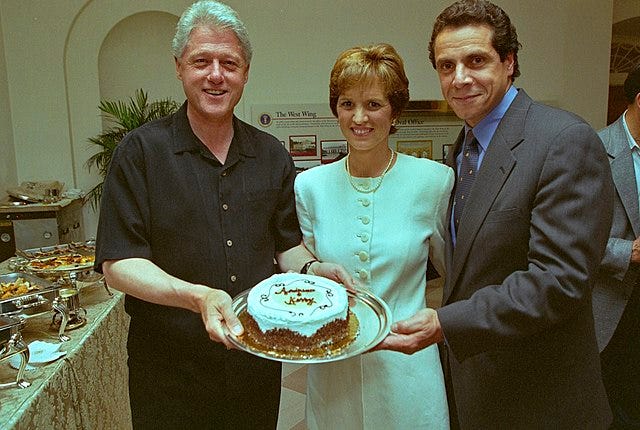
It was obvious that Andrew Cuomo was going to run for Mayor months before he announced. The former Governor, who resigned in disgrace in 2021 after a slew of withering sexual harassment allegations and an investigation from State Attorney General Letitia James, an Adrienne Adams ally who was once discussed as a potential major mayoral contender herself, was plotting a political comeback in a post-#MeToo era of politics where such scandals matter less and less to voters these days. Polls from several months ago showed Cuomo as the top choice for NYC voters above disgraced mayor Eric Adams, whose rap sheet could wrap around the entirety of Staten Island twice over, and every single other potential contender. The former Governor had won over Eric Adams’s 2021 base even before his March 1st announcement that, yes, Andrew Cuomo was running for Mayor, and especially in the month or so that both Cuomo and the Mayor were running in the Democratic primary. Ever since then, Cuomo has led every single ranked-choice poll in the final round, launching himself as the guy with the most name recognition, the most support, the most Democratic institutional backing, and the most money (or wealthy backers, depending on who you ask). Cuomo was inevitable. His Fix the City PAC has spent millions trying to get him elected, which is a luxury that no other campaign possesses. The same is true for his endorsements from elected officials, organizations, and unions, who, from Reps. Adriano Espaillat and his local Dominican machine to Trump-supporting billionaire Bill Ackman to former Mayor Mike Bloomberg and LiUNA! were more than willing to jump on the wagon of the guy with the biggest one. Cuomo’s support from many labor unions, including local SEIU and Teamsters chapters, are crucial in maintaining his working-class base across the city. His name recognition, which he got both from his handling of COVID and his handling of the women he harassed, would be by far the highest among a field of hopeless challengers, and tons of New Yorkers would go to the polls knowing only Cuomo. Better the devil you know than the devil you don’t. Tilson and Ramos have both backed his campaign, looking to shore up margins with expected Cuomo strongholds along the Upper East Side and in potential Latino battlegrounds in Corona. The biggest newspapers, like the conservative New York Post and the liberal yet ever controversial New York Times, are all implicitly coming to his aid by bashing the other main contender, which is a major development considering the Gray Lady near single-handedly put Kathryn Garcia in Gracie Mansion four years ago. Whether you like him or not, at least you’ve heard of him, and among a field of contenders whom most New Yorkers haven’t heard of, that is possibly the biggest advantage of all. Cuomo is running as the candidate to keep New Yorkers safe in a chaotic world; he has branded himself as the crimefighter who will keep subways safe, make housing more affordable, clean up the city, combat antisemitism, and fight Trump and the evils of the world. Andrew Cuomo is the Big Kahuna among a field of ants. Good luck trying to challenge him, because he has more of almost everything than everyone else, and everyone knows it… at least, that’s what he wants New Yorkers to think.
That veneer of invincibility has slipped tremendously, and it’s not like he’s run the smoothest campaign of all time. His Fix the City PAC has cost him $1.3 million dollars in public matching funds because his campaign illegally coordinated ad spending with the PAC, which is illegal in New York City - the second time in a month the city’s Campaign Finance Board financially punished the Cuomo campaign. His debate performances have been rather poor so far, partially due to withering attacks from the rest of the field and partially due to his own mistakes. The endorsement he got from State Sen. Jessica Ramos is far more likely to see Ramos get the boot in a future primary than for Cuomo to gain Latino support from it. Cuomo is also having some trouble locking up key areas and demographics that are expected to go for him; Adrienne Adams could massively eat into his support with Black voters and he also might be having trouble holding on to Latino and Asian voters. He was even at risk of losing some Hasidic support in Borough Park to Adrienne Adams before a late meeting secured their endorsement of his campaign at first rank. Just before I went to hit publish on this shit, Cuomo was hit with an ethics complaint from the Foundation for Accountability and Civic Trust, a right-leaning watchdog, for failing to disclose over $2.6 million in stock options in Nano Nuclear Energy, a Tennessee-based nuclear microreactor company whose board Cuomo got a seat on last year. If you want to know how sick of Cuomo even some establishment candidates are, AG Letitia James, the major backer of Adrienne Adams, put out a fully ranked slate that has Cuomo as close to the ballot as Selma Bartholomew, with a rank of his major opponent included to boot. As he is starting to lose his once-iron grip on the field of challengers, his campaign mailers have increasingly appealed to experience, anti-socialist bonafides, pro-Israel sentiment among older Jews, opposition to Defund the Police (which Cuomo once claimed was a legitimate line of thought in the summer of 2020), and perhaps some anti-Muslim bigotry along the way. Oh hey, it’s the Doordash-funded Fix the City PAC! Despite all of this, however, he still leads by a fairly decent margin in most polling. As of writing, there has not been a single poll released which shows anyone besides Cuomo winning the primary in the final round of voting. Take it from pro-Cuomo, anti-Cuomo, and independent polls, despite all of the developments that have taken place since his campaign’s launch.

Eric Adams’s 2021 victory over Kathryn Garcia was described by @socialconcarne of Bluesky as “the working classes of New York City overcoming the will of most of the elites,” as Joe Biden was nationally in 2020. While Cuomo’s coalition will have a lot more elites than Adams had in his, Cuomo’s base will largely consist of working-class voters of color, particularly Black voters. Many of his closest supporters and strategists are still acting as if they have already won the race, and it is very possible that despite everything I have talked about there and his very, very tepid approval ratings among NYC Democrats, he will simply have started from too good of a position, gotten too much money from the city’s elites, received too many half-assed endorsements from desperate newspapers looking to avoid the shock of all shocks, and spent too much money on TV ads to lose a race that was always supposed to be his. After all, to borrow a phrase from rising college football Youtuber Red5478, money talks and bullshit walks, and Cuomo’s high floor may be enough to tell the other candidates to take a hike. It is also possible, however, that through his own fuckups and the meteoric rise of a certain socialist State Assemblyman, that Andrew Cuomo will somehow manage to bottle a 40 point lead in the Democratic primary to become the Mayor of America’s largest city. You may ask yourself “how is this possible?” Well, readers, let me take you on a journey.
Zohran Mamdani and the Rise of the Left
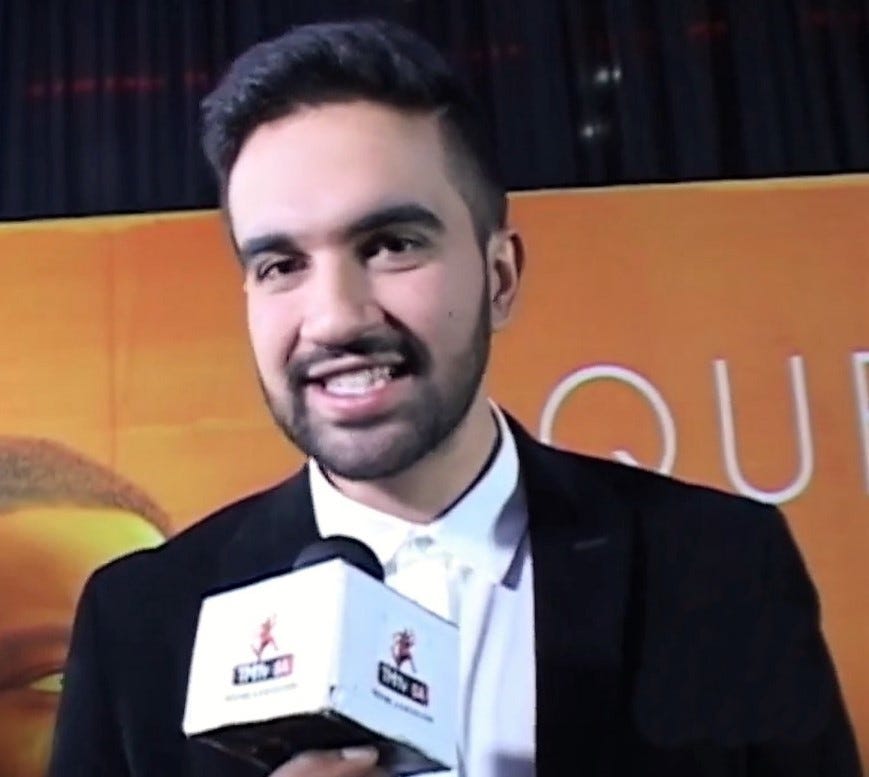
The year is 2020. Incumbent State Assemblywoman Aravella Simotas, a Greek-American politician representing the historically Greek neighborhood of Astoria, in the 34th Assembly District, was facing a primary challenge from a South Asian Muslim born in Uganda who just so happened to be a candidate from Democratic Socialists of America. Astoria was changing, although in different measures than other NYC neighborhoods; while it was getting less white and, in particular, more Asian, Astoria’s major change was ideological, as it was becoming a hub of the left ascendant rather quickly. It helped power a socialist Bronx bartender to a shocking upset over House Democratic leader Joe Crowley and was electing socialists to all areas of government. Simotas, a representative of the old Greek establishment, would be yet another casualty of the developing People’s Republic, the new socialist establishment in the area, as she would end up losing her primary by just under 2.6%, or by 423 votes. Her opponent was able to break through and win voters south of Astoria Boulevard while not getting blown out too badly in Steinway. Five years later, that opponent, Zohran Kwame Mamdani, and the movement that propelled him to a political career are on a collision course with essentially the entire New York Democratic Party establishment for control of New York City. How the hell did Zohran do it? Well, blame social media, Andrew Cuomo’s desires, and perhaps the God-honest best-run Democratic campaign I have seen in years.
No discussion of Mamdani’s mayoral campaign should start without talking about a slogan. Freeze the rent, free and fast buses, and free childcare. It’s radical enough to be a hallmark of a socialist economic pitch while also being simple enough to be effective when drilled into voters’ heads. Mamdani’s pitch is to bring a more affordable New York, and that the city simply costs too damn much for many to feasibly live in. So why not focus on three policies that most New Yorkers could see as reducing costs? After all, that’s what Trump used to win over America last year. His message discipline should also receive a mention, as should that have any candidate who can somehow use a question about the Drake-Kendrick Lamar beef to reference their mayoral pitch. Next, I have to talk about the best social media and digital advertising campaign I have ever seen in Democratic politics. His digital videos earn constant praise from even the more critical commentators as an endorsement of both his video team and his personal charisma. Whether he was conducting street interviews with Knicks fans and Trump voters about the cost of living or boarding the Staten Island ferry to legitimize free buses or creating early voting graphics that wouldn’t look out of place on many family WhatsApp groups, Mamdani has been able to create the largest and most widespread donor base of any candidate in the race. Ads where he is speaking Spanish and Hindustani (or Urdu, or Hindi?) have proven that he is serious about breaking through in areas where many diverse languages are spoken; think the already left-leaning Jackson Heights and the belt from Glen Oaks to Jamaica. Unlike many on the left in recent years, Mamdani also understands that it is essential to run TV ads to each older and less tuned-in voters, especially in a city as big as New York is, even if he is getting swamped by Fix the City. Jamaal Bowman, Nydia Velázquez, and others have starred in TV ads meant to win over the exact kinds of voters who have only heard of Andrew Cuomo - a core part of Cuomo’s base. Finally, I have to talk about the incredible canvassing operation he has, a hallmark of any NYC-DSA political operation. The largest branch of Democratic Socialists of America, the largest explicitly leftist movement in the United States, has used this strategy to win race after race in the city, including, notably, in Mamdani’s own successful 2020 campaign, while turning outer borough neighborhoods along the East River into left-wing strongholds. Mamdani is not here if DSA does not put years of organizing, of which he is a part of, into winning elections and establishing the Commie Corridor and a certain floor of support for citywide socialist candidates. Emblematic of this is a digital ad he cut highlighting the language diversity of his canvassers, who have knocked just over a million doors as of writing. Of course, it is a lot harder to lean on canvassing when trying to win a race that should see north of a million voters, especially in a city and media market as big as NYC, so it has to be damn near perfect to make a serious dent. Fortunately for Mamdani, his operation meets the threshold. It is by far the best canvassing operation of the entire field and is the only one to try and expand a coalition instead of merely hitting core strongholds. Examples include operations in Bay Ridge, Parkchester, Van Nest, Westchester Square, and Jamaica, where the campaign is trying to bring out favorable demographics, most notably South Asians, Arabs, and Muslims, and expand the left-wing electorate in key areas. Additionally, he is trying to cut into Cuomo’s lead with Black voters in Co-Op City (thank you Jamaal Bowman), East Flatbush, East New York, East Crown Heights, and Harlem and with Dominican voters in Washington Heights and the South Bronx. Fundamentally, it is an ambitious operation that aims to harden current strongholds (Astoria, Greenpoint, and Park Slope, for example) and find neighborhoods with favorable demographics that could become competitive or even favorable territory with the right pressure. Remember, Cuomo’s team wanted to run against him - after all, such an entrenched name could never lose to a no-name socialist, not in the Big Apple.
It has finally culminated in Mamdani leading a poll… for Public Policy Polling, an admittedly not-great pollster who conducted an internal for the Justin Brannan campaign for Comptroller, found the City Councilman from Brooklyn down 11 points to Manhattan Borough President Mark Levine, and had Mamdani leading Cuomo 35%-31% in the first round. Cuomo’s team responded with different internals for the campaign and his Fix the City PAC that showed him with varying commanding first round leads. It was here when Mamdani and Lander, the two left-wing candidates in the race, cross-endorsed each other, which should give Mamdani an extra foothold in Brownstone Brooklyn and Manhattan. Mamdani also secured a cross-endorsement with the Bronx’s Michael Blake, which proves that he is actually serious about that whole “competing in the Bronx” thing. Finally, Mamdani has the broader national left on his side, securing the endorsements of Rep. AOC last week and a certain Sen. Bernie Sanders, who did not endorse anyone in 2021, just before publication. All of this to be competitive with a walking sexual harassment allegation, huh?
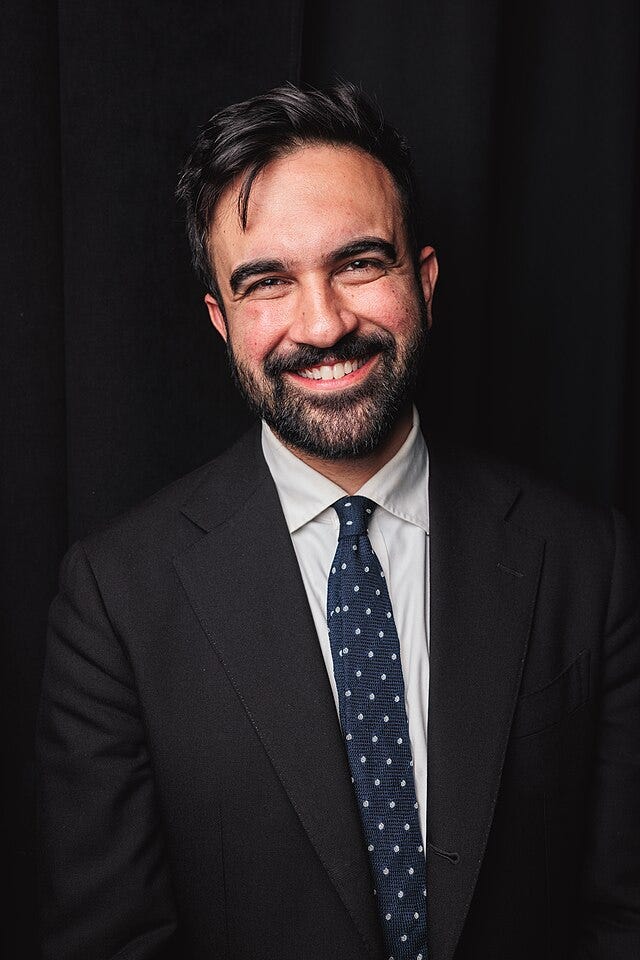
If Mamdani is able to pull this off, overcome a deficit that was as large as 40 points at one point, and win this Democratic primary, it will be representative of a few things. First, like 2020’s narrow State Assembly primary victory, it will be representative of a changing and more diverse New York, as an Italian Catholic would be losing a Democratic primary to a South Asian Muslim immigrant. Secondly, it would represent an all-time Cuomo Chokejob that would be worse than anything the Atlanta Falcons could ever dream of. Remember, Cuomo had a 40 point lead at one point; the Falcons only blew a 25 point lead. Thirdly, and perhaps most importantly, it would represent a shot across the bow of Democratic politics. Even though the race is being fought mostly on local issues, a party base that is both fearful of President Trump ending American democracy and more radical in its opposition to him deciding to choose a Muslim socialist over a moderate liberal and former (and formerly popular) Governor backed by the city’s wealthiest donors and groups to run the biggest city in America, which also happens to serve as an emblem of the Democratic Party writ large and as the country’s cultural and media capital, would be the win that the party’s left has been looking for since Bernie Sanders’s rise in 2016 and the event that could kick off a Democratic Tea Party. Do you know what could happen if the city where most major mainstream media companies are headquartered (sorry, CNN and WaPo) elected a socialist Mayor? That win would inspire so many left-wing campaigns across the country who would be buoyed by the upset and would try to emulate Mamdani’s campaign. And think about what having a cadre elected official winning the primary would do for DSA itself, which has most definitely stagnated both in membership and in wins in the 2020s after Bernie’s unsuccessful 2020 Presidential bid. Such a win would revitalize not only the entire socialist movement, giving them a win not seen in decades, but also give a huge leg up to the electoralists within the movement looking to take advantage of favorable currents. How cruel, then, would it be for a campaign which has obtained almost unstoppable momentum to fall short at the final hurdle?
So now that I have described the two candidates who can actually win this damn thing, it’s time to look at the election itself. How will it go, where will the candidates find their strongest support, and what would winning coalitions look like for Andrew Cuomo and Zohran Mamdani? Let’s first go over the two candidates’ differing bases of support.
Andrew Cuomo
Andrew Cuomo’s job should be simple. In order to win this primary, he has to cobble together a coalition of voters who supported Eric Adams, Kathryn Garcia, and Andrew Yang in 2021. He has to win the Black voters who supported Adams, the moderate and liberal white voters in Manhattan, Queens, and Staten Island who supported Garcia, and the East Asian and Orthodox Jewish voters who went for Yang. If he replicated those feats, he would win over 62% of the vote, and just like the Democratic primary for NJ Governor, we’d be wondering why the hell we thought this race was ever competitive. The good news for Cuomo is that he doesn’t have to do that; he just has to get 50% plus one vote. He can afford for Adrienne Adams to peel off a decent chunk of Black voters, he can afford to lose some Garcia supporters in Manhattan to Lander or even Mamdani, he can afford to lose some East Asian support to Stringer, he could afford to lose institutional support from Puerto Rican politicians such as AOC and Nydia Velázquez to Mamdani, and he could even afford to lose some votes from Orthodox Jews who remember how he treated their communities during the COVID pandemic. But can he afford for all of these things to happen? That is the bigger question, and it also doesn’t help when one of the most prominent Taiwanese-American politicians, who happens to represent a heavily Chinese State Senate district centered in a supposed Cuomo stronghold such as Flushing, a Yang stronghold from 2021, endorses Mamdani as his first choice. This is especially true when East Asians, who swung hard to the right over the crime issue in the 2020s, which is supposed to be Cuomo’s strongest issue, are supposed to be one of Cuomo’s strongest constituencies. Oh yeah, speaking of Cuomo’s strongest constituencies. His base will be centered around six core areas. First is Staten Island, which should go gangbusters for him but only represent 3% of the Democratic electorate, a 3% that may be crucial in a close race. I am interested to see how the more diverse communities along the northern shore differ to the rest of Staten Island, which will be strongly Italian pro-Cuomo territory. Second is South Brooklyn, which contains strong Chinese communities in Bensonhurst and Russian/former Soviet communities in Brighton Beach which went for Yang and Adams respectively. There is also the whole Italian thing which should help Cuomo there. Third is Black voters in general, who will be concentrated in East Brooklyn, Southeast Queens, and the Bronx. Cuomo has been strong with these communities from the jump, and if he’s not dominating here, especially in Eric Adams’s home of East Brooklyn and in the Bronx, he has very serious issues across the city. Fourth is North Queens, which is mostly dominated by heavily Italian (Beechhurst) and Chinese communities (Flushing) that split for Garcia and Yang and should very much be a core stronghold; after all, Cuomo was born in Queens. Fifth is the Bronx, which is dominated by Black communities in the north (Wakefield), Dominican communities in the West Bronx, and Puerto Rican communities in the East Bronx with an Italian presence, especially around Throgs Neck and Morris Park. Cuomo should do very well here, although I could see Mamdani and Adams take chunks out of the Bronx electorate. There is also the Northwest Bronx, which has large Jewish and ethnic white populations that largely went to Garcia in 2021 and should also benefit Cuomo in 2025. Finally, sixth is the Upper East Side/Lenox Hill area of Manhattan, which is an ancestrally GOP area that is very white, very wealthy, very educated, and, importantly, not left-wing: exactly the type of area where Garcia dominated in 2021 and where Cuomo would find his strength in Manhattan besides Upper Manhattan and Harlem, which is heavily Dominican and African-American respectively. This is the Cuomo Coalition: outer borough moderates and Black voters supported by Manhattan liberals who remember him fondly for helping them get through COVID and aren’t exactly willing to elect a socialist in Democratic primaries. Generally, it should be filled with Black voters, moderate to liberal white voters, East Asian voters, Latino (especially Dominican) voters, and those over 45 years old.
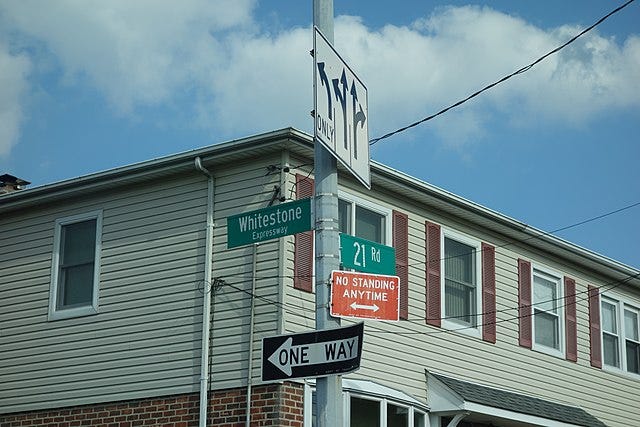
Zohran Mamdani
In order to understand any NYC leftist’s citywide campaign (or any supported by the city’s left), you have to understand the Commie Corridor. By a narrower definition, it is an area of neighborhoods stretching from Astoria in northwest Queens to Bushwick in north Brooklyn, and by more liberal definitions extends to diverse Jackson Heights in Jessica Ramos’s state Senate district. The Commie Corridor is both plurality white (minus Bushwick) and very consistent in its support of leftist candidates. Ironically, Astoria, which is Mamdani’s home, the beating heart of the Corridor, and often jokingly branded as the People’s Republic because it is represented by DSA members from the City Council to the House of Representatives, may be the least left-wing neighborhood of the bunch. Its white populations, especially around Greenpoint, are highly educated, and a variety of Latino communities can be found in Ridgewood and Bushwick at its southern end. This is where Mamdani’s greatest strength always was going to be, and with his ascension as the main left-wing candidate, he will pull numbers that Maya Wiley could only dream of out of here. Remember, her campaign’s rise was the result of the left scrambling for answers after Scott Stringer’s own harassment allegations and Dianne Morales’s spectacular disaster of a 2021 mayoral campaign; Mamdani is no fallback option. The areas which explain why Mamdani completely stole Brad Lander’s thunder can be found south of there in Brownstone Brooklyn, an area dominated by brownstones (no shit!) and progressive white voters. This area, which contains Lander’s home base of Park Slope, could be considered as a Commie Corridor South, or even a part of it if you just ignore the buffer that South Williamsburg provides. This area stretches from portions of Bedford-Stuyvesant to Kensington, and similarly to its ideologically similar counterpart to its north, it is a hub of NYC’s progressive movement that backed Wiley in 2021, Unlike the Commie Corridor, Garcia found support in areas like Cobble Hill and eastern Park Slope, and Mamdani will have to make sure Cuomo doesn’t earn himself a foothold in these areas. It is in these areas specifically where early voting turnout is the best as of writing. These two regions powered Maya Wiley to over 21% of the vote, but Mamdani needs to exceed 30% citywide in the first round to have any shot of beating Cuomo. Where he can find that extra 10+% lies chiefly with three key demographics.
First, I have to talk about Arab and Muslim voters. In the mid-2020s, Palestine has come up as a major issue for these and left-wing voters, and Zohran Mamdani is **the** pro-Palestine candidate in the race. Voters who would otherwise lean Cuomo or simply not vote have a champion in the race, and this will lead Mamdani to pockets of support almost no other candidate can access. This will be especially pronounced in South Brooklyn; neighborhoods like Bay Ridge, Fort Hamilton, Bath Beach, Gravesend, Midwood, and Sheepshead Bay all have very large Arab populations, and while most of these neighborhoods will be Cuomo strongholds, the Arab vote will lend itself to Mamdani cutting the margins here. Bay Ridge, a moderately pro-Garcia neighborhood, in particular is going to be a very interesting place due to its moderate nature and very large Arab populations. Wiley, Yang, and even Eric Adams found pockets of support in the region - can Mamdani overtake Cuomo here? Other areas of note are in Van Nest in the Bronx and - of course - Astoria in Queens.
Secondly, South Asian voters, similarly to Arab voters, did not gravitate to one candidate in 2021 the same as they are likely to gravitate to a Hindustani-speaking South Asian candidate in 2021 (or Hindi, or Urdu, don’t yell at me). There is a belt in Queens stretching from Glen Oaks to Hillside which separates North Queens and Southeast Queens, is very diverse, and is filled to the brim with South Asian voters where Mamdani could do very well in. There is a specifically large Indian-American population around South Ozone Park and Morris Park (different from the Bronx one) as well, although I expect Mamdani to do a bit worse with Indian voters than other South Asians like Pakistanis and Bengalis who are more likely to be Muslim. Cuomo himself is from Holliswood, as is Cuomo-backing State Assemblyman David Weprin. I would also watch Parkchester in the Bronx, Woodside and Jackson Heights in Queens, and Kensington and Parkville in Brooklyn.
The third, and perhaps most crucial demographic, is Manhattan. What polls we have of the race suggest that Zohran Mamdani is performing best with white college educated voters. Besides Mamdani’s two strongholds, where else can you find them than in most of Manhattan? This area is crucial for a number of reasons. Like a ton of Cuomo’s supposedly strongest areas, it went hard for Kathryn Garcia in 2021, but unlike those areas, it is seen as a crucial battleground. With the Upper East Side, alongside a lot of Upper Manhattan neighborhoods such as Washington Heights and Harlem expected to be pro-Cuomo territory, where can Mamdani find the numbers? I would look first towards lower and especially midtown Manhattan. These areas have a lot of voters under 40 years old, which are disproportionately pro-Zohran in the public polls we have. I would look towards areas such as Murray Hill, Hell’s Kitchen, Koreatown, and East Village to see if Mamdani has made a breakthrough there. The Lower East Side has a lot of areas with diverse support bases, with Adams, Garcia, Wiley, and Yang all finding areas of support there in 2021. so I will be intrigued to see how that area splits in particular. Mamdani could potentially achieve breakthroughs in Morningside Heights, home to the ever-so contentious Columbia University, and the area from Inwood to Hudson Heights in Upper Manhattan as well. However, my main question is the Upper West Side. It is a historically Jewish and liberal neighborhood, having gone heavily for Garcia in 2021 and being instrumental in victories for Brad Lander and Mark Levine that year. It is the supposed historic home base for Scott Stringer, a secondary candidate who was being challenged in the area by Brad Lander some months ago. Maya Wiley also placed 2nd in most precincts in the area, ahead of Adams, Yang, and Stringer in 2021. The Upper West Side is very old in relation to the city, as a majority of the people - and supermajority of the voters - are above 40 years old, which is a strength for Cuomo. The questions I have are these: where do Cuomo and Mamdani start, and where do UWS supporters of Stringer and Lander go after their candidates are eliminated? I believe that the answers we get here in a week and in two weeks respectively will be very instrumental in determining the next Mayor of New York City. Whatever the answer is here, one cannot deny that Zohran Mamdani has risen from a little-known socialist to Andrew Cuomo’s only relevant opponent. His base is concentrated among liberal and leftist white voters, South Asian voters, Arab and Muslim voters, and voters under 45, with a potential breakthrough among Latino voters spotted in the most recent polling.
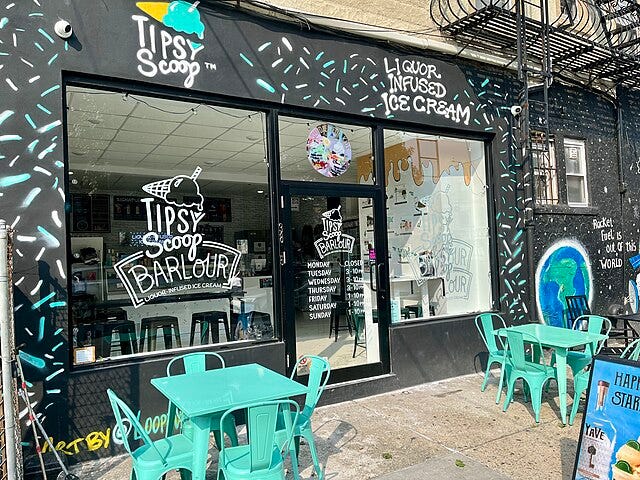
What Will The Winning Coalition Look Like?
So the question that is at the heart of this mayoral race finally comes to the surface: Can Andrew Cuomo fend off the sharks in the water to cement his political comeback, or can Zohran Mamdani deliver one of the most shocking upsets in modern American politics? While we won’t likely know who wins until July 1st, a week after voting, here’s how winning coalitions could look for both candidates.
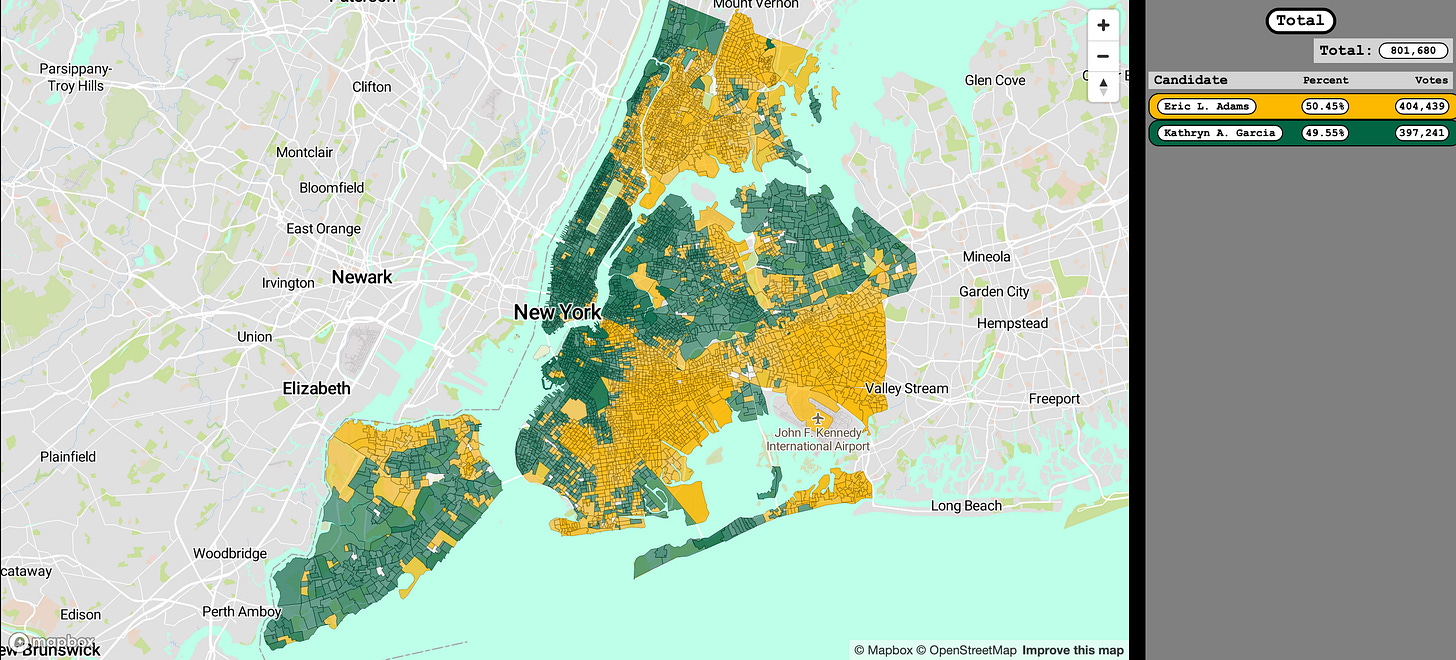
The simplest way for the Cuomo campaign to game this out is to look at the 2021 mayoral map. If he can replicate the Eric Adams coalition and add the moderate white and East Asian voters that went for Kathryn Garcia, it’s over. However, this assumes that a white Italian from Queens (or Manhattan, or Westchester, depending on how you look at it) can replicate a Black Brooklynite’s performance among Black voters. A little-talked about phenomenon could also make or break Cuomo’s coalition. It’s the fact that, in a lot of these areas, the GOP has made enormous gains and cut Cuomo off from a good chunk of former Democratic votes. North Queens, South Brooklyn, Staten Island? These areas all swung tremendously hard against Gov. Kathy Hochul, his successor, from 2020 President to 2022 Governor. The Bronx, Upper Manhattan? They swung sharply to the right from 2022-2024 as a huge minority of Latinos, particularly Dominicans, broke away from the Democratic Party and went for Trump. Because the GOP has hit 30% of the NYC vote in the past two major elections here, a lot of otherwise moderate to conservative Democratic votes that would otherwise go to Cuomo are now either not voting or headed straight for Curtis Sliwa, the GOP nominee in November. There are Zeldin-Harris voters in the former areas he should win very comfortably, but if it’s an exceptionally close race and voters who are otherwise friendly to your campaign have simply stopped being Democrats, that’s gonna be a really big fucking problem for you. With early voting numbers already indicating lagging growth for pro-Cuomo boroughs compared to Manhattan and especially Brooklyn, this issue becomes even more relevant. As an aside, while Staten Island and the Bronx are safe Cuomo boroughs, Queens is must-win territory; if Mamdani, who is from Queens, can somehow pull off the upset in the most diverse borough of the city, it’s curtains for Cuomo.

As for Mamdani, I would look at Brad Lander’s nearly four point win over Corey Johnson for the 2021 Democratic primary for NYC Comptroller. Lander engaged in an over 16 point beating of Johnson in Brooklyn and an over 13 point win in Manhattan while keeping Queens somewhat competitive and losing the other boroughs decisively. This, I believe, is a decent barometer for a progressive victory between two non-Black candidates in the city, with the former Speaker of the City Council unable to garner the same support from Black New Yorkers as Eric Adams did while also decisively losing Manhattan to Lander outside his own city council district, centered around Chelsea and Hell’s Kitchen. Mamdani will need to perform a similar job, perhaps swapping Lander-Cuomo voters in Manhattan, particularly in the Upper East Side, for new gains in Central and Southeast Queens. Even with this reality, Manhattan is likely a must-win borough for Mamdani, as there is only so much one can get from Brooklyn and if Mamdani is strong with white, college educated voters, there is no other place besides Brooklyn where they are predominant. If Cuomo can hold on to the borough, then Mamdani’s 2025 mayoral campaign will experience Kamala Harris Syndrome; simply having too big of a hole to climb despite what momentum the campaign had.
Ultimately, what this comes down to is how Mamdani is defined for the quarter to third of NYC voters who are yet to hear of him. Cuomo and his allies are spending big to drive his unfavorables up, including staging an admittedly pathetic Reject Zohran rally in heavily Orthodox Kew Gardens Hills and spending millions on negative TV ads. Mamdani will struggle to catch up on TV, but likely absolutely lap him in canvassing (thanks, NYC-DSA) and especially on social media. Cuomo himself is at 50/50 approval rating among NYC Democrats, and the fact that Mamdani, Lander, Adams, Stringer, Myrie, and Blake are all running variations of anti-Cuomo campaigns, with Lander and Blake ranking Zohran #2, won’t help that.
The game is this: if Cuomo can hold on to the voters who recognize and like him, he likely wins a race that he should have had in the bag to begin with. If Mamdani can reach the soft Cuomo voters who don’t know him before Cuomo defines him, and if he can beat Cuomo decisively in Manhattan, we might be looking at an upset rivaling the likes of 2007 Appalachian State, 2017 Howard, or - and this might be sacrilege to say - 2018 AOC. Either way, early voting has started in New York City, the wagons are circling around their candidates, and Election Day will soon commence.
Brace yourselves.





Will you be doing any more “Congressional Filings” posts in the future?